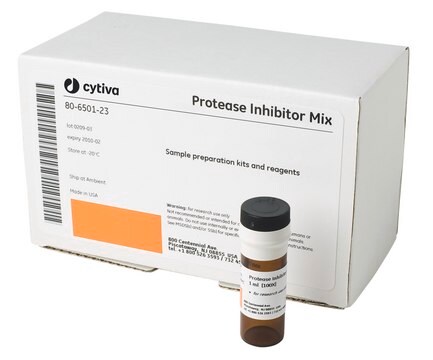P8465
Protease Inhibitor Cocktail
lyophilized powder, for the inhibition of serine, cysteine, aspartic, metalloproteases and aminopeptidases, for use with bacterial cell extracts, lyophilized powder
Synonym(s):
Protease inhibitor
Sign Into View Organizational & Contract Pricing
All Photos(1)
About This Item
UNSPSC Code:
12352200
NACRES:
NA.77
form:
lyophilized powder
storage temp.:
−20°C
Recommended Products
Product Name
Protease Inhibitor Cocktail powder, for use with bacterial cell extracts, lyophilized powder
Quality Level
form
lyophilized powder
storage temp.
−20°C
Looking for similar products? Visit Product Comparison Guide
Related Categories
General description
The Protease Inhibitor Cocktail is a lyophilized powder for use in the inhibition of proteases present in bacterial cell extracts.
The product contains individual components that target serine, cysteine, aspartic, and metalloproteases, as well as aminopeptidases.
The product contains individual components that target serine, cysteine, aspartic, and metalloproteases, as well as aminopeptidases.
Application
The protease inhibitor cocktail improves the yields of intact proteins by adding inhibitors to enzymes that modify proteins present in cell extracts. This product has been optimized and tested for bacterial cell use, with broad specificity against serine, cysteine, and aspartic proteases, metalloproteases, and aminopeptidases.
Biochem/physiol Actions
This mixture contains individual components, including AEBSF at 23 mM, EDTA at 100 mM, Bestatin at 2 mM, Pepstatin A at 0.3 mM, and E-64 at 0.3 mM. AEBSF acts to inhibit serine proteases, including trypsin, chymotrypsin, and plasmin amongst others. Bestatin inhibits aminpeptidases. E-64 acts against cystein proteases. Pepstatin A inhibits acid proteases. EDTA is an inhibitor of metalloproteases.
Features and Benefits
Broad specificity against serine, cysteine, aspartic, and metalloproteases, as well as aminopeptidases.
Contains individual components, including AEBSF, EDTA, Bestatin, Pepstatin A, and E-64, each targeting specific types of proteases.
Lyophilized powder is stable for at least 2 years when stored unopened at -20°C.
Supplied with a vial of DMSO for preparation of a cocktail solution.
One mL of the cocktail solution is recommended for the inhibition of protease activity found in 20 mL of cell lysate from 4g of E. coli cells.
Contains individual components, including AEBSF, EDTA, Bestatin, Pepstatin A, and E-64, each targeting specific types of proteases.
Lyophilized powder is stable for at least 2 years when stored unopened at -20°C.
Supplied with a vial of DMSO for preparation of a cocktail solution.
One mL of the cocktail solution is recommended for the inhibition of protease activity found in 20 mL of cell lysate from 4g of E. coli cells.
Caution
The lyophilized powder is stable for at least 2 years when stored unopened at -20°C. It is also supplied with a vial of DMSO. A prepared solution in DMSO and water will remain clear and colorless for approximately 24 hours at 4°C, before the inhibitors will precipitate out.
Preparation Note
A cocktail solution may be prepared by adding 1 mL of DMSO and 4 mL of deionized water to the 5 mL size or 5 mL of DMSO and 20 mL of deionized water to the 25 mL size. One mL of the cocktail solution is recommended for the inhibition of the protease activity found in 20 mL of cell lysate from 4g of E. coli cells.
related product
Product No.
Description
Pricing
Signal Word
Danger
Hazard Statements
Precautionary Statements
Hazard Classifications
Acute Tox. 4 Inhalation - Eye Dam. 1 - Met. Corr. 1 - Skin Corr. 1A - STOT RE 2 Inhalation
Target Organs
Respiratory Tract
Storage Class Code
8A - Combustible corrosive hazardous materials
WGK
WGK 3
Personal Protective Equipment
dust mask type N95 (US), Eyeshields, Gloves
Choose from one of the most recent versions:
Already Own This Product?
Find documentation for the products that you have recently purchased in the Document Library.
Customers Also Viewed
Kerri Kobryn et al.
Molecular cell, 9(1), 195-201 (2002-01-24)
The genus Borrelia includes the causative agents of Lyme disease and relapsing fever. An unusual feature of these bacteria is a segmented genome consisting mostly of a number of linear DNA molecules with covalently closed hairpin ends or telomeres. In
Evgeniy V Petrotchenko et al.
Molecular & cellular proteomics : MCP, 11(7), M111-M111 (2012-03-23)
Chemical cross-linking combined with mass spectrometry is a rapidly developing technique for structural proteomics. Cross-linked proteins are usually digested with trypsin to generate cross-linked peptides, which are then analyzed by mass spectrometry. The most informative cross-links, the interpeptide cross-links, are
H Cao et al.
Plant physiology, 120(1), 205-216 (1999-05-11)
This study identified the complement of soluble starch synthases (SSs) present in developing maize (Zea mays) endosperm. The product of the du1 gene, DU1, was shown to be one of the two major soluble SSs. The C-terminal 450 residues of
Frank Gillardon
Journal of neurochemistry, 110(5), 1514-1522 (2009-06-24)
Autosomal dominant mutations in leucine-rich repeat kinase 2 (LRRK2) are the most common genetic cause of late-onset Parkinson's disease. The most prevalent LRRK2(G2019S) mutation has repeatedly been shown to enhance kinase activity and neurotoxicity, however, the molecular mechanisms leading to
N Borruel et al.
Gut, 51(5), 659-664 (2002-10-16)
Tumour necrosis factor alpha (TNF-alpha) plays a key role in the pathogenesis of intestinal inflammation in Crohn's disease. The effect of bacteria on TNF-alpha release by intestinal mucosa was investigated. Ileal specimens were obtained at surgery from 10 patients with
Our team of scientists has experience in all areas of research including Life Science, Material Science, Chemical Synthesis, Chromatography, Analytical and many others.
Contact Technical Service


















